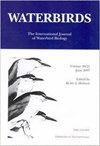Group Adherence in Endangered California Least Terns (Sternula antillarum browni)
IF 0.6
4区 生物学
Q3 ORNITHOLOGY
引用次数: 1
Abstract
Colonial nesting in seabirds is advantageous for protection from predators—spotting a predator, mobbing, and predator swamping. Familiarity with nesting areas gives knowledge of protected sites and may promote site fidelity. Familiarity with nearest neighbors helps nesting success by lessening intraspecific aggression and increasing social facilitation, and may promote group adherence. Group adherence has been proposed as more important than site tenacity for some species where nesting areas are frequently disturbed. Ground-nesting terns often nest at disturbed sites, and their colonies are accessible to predators. Serendipitously, I was able to test the concept of group adherence in individually color-marked California Least Terns Sternula antillarum browni during early egg-laying when some nests in a colony in southern California were depredated, and the adults deserted. A week later, I found the majority of those birds nesting at the edge of a small Least Tern colony 28 km distant, where they laid a second clutch and remained at the site the rest of the breeding season. The following breeding season, no color-marked terns nested again at the small colony where they had moved after disturbance.濒危加利福尼亚最小燕鸥(Sternula antillarum browni)的群体依附性
海鸟的群体筑巢有利于保护自己免受捕食者的攻击——发现捕食者、围捕和淹没捕食者。对筑巢区域的熟悉有助于了解受保护的地点,并可能提高地点的保真度。熟悉最近的邻居有助于筑巢成功,减少种内攻击和增加社会便利,并可能促进群体的团结。对于一些筑巢区经常受到干扰的物种来说,群体粘附性比地点坚韧性更重要。地面筑巢燕鸥经常在受干扰的地方筑巢,它们的栖息地容易被捕食者接近。偶然的机会,我能够在加利福尼亚最小燕鸥(California Least Terns Sternula antillarum browni)产卵早期测试群体团结的概念,当时南加州的一个群体的一些巢穴遭到破坏,成年燕鸥被遗弃。一周后,我发现这些鸟中的大多数都在28公里外的一个小燕鸥群的边缘筑巢,在那里它们产下了第二窝,并在那里度过了繁殖季节的剩余时间。在接下来的繁殖季节,没有任何颜色的燕鸥在它们被干扰后搬到的小群体中筑巢。
本文章由计算机程序翻译,如有差异,请以英文原文为准。
求助全文
约1分钟内获得全文
求助全文
来源期刊

Waterbirds
生物-鸟类学
CiteScore
1.30
自引率
0.00%
发文量
0
审稿时长
6-12 weeks
期刊介绍:
Waterbirds is an international scientific journal of the Waterbird Society. The journal is published four times a year (March, June, September and December) and specializes in the biology, abundance, ecology, management and conservation of all waterbird species living in marine, estuarine and freshwater habitats. Waterbirds welcomes submission of scientific articles and notes containing the results of original studies worldwide, unsolicited critical commentary and reviews of appropriate topics.
 求助内容:
求助内容: 应助结果提醒方式:
应助结果提醒方式:


